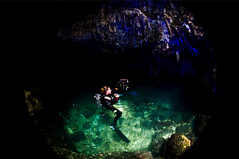How extreme do you want your sport to be?
What is your comfort level with risk?
When it comes to scuba diving, these are questions you will have to ask yourself if you wish to advance to some of the more extreme elements of the sport.
That is one of the strengths of scuba. It’s versatile. You can choose the level at which you wish to participate.
“Scuba is not extreme, but it lends itself to extremes,” says Catherine Donker, a dive master from St. Thomas, Ontario, Canada. “It is user friendly. You can take a casual approach if you are not looking for a lot of physical challenge or excitement. You can choose dives according to your level or interest. You can do 15-to-20 foot dives on top of a reef or if you’re getting into the extremes, a wreck such as the Andrea Doria.”
While approaching the coast off Nantucket, Massachusetts, the Andrea Doria and the eastbound freighter MS Stockholm collided. The Andrea Doria sank on July 26, 1956, resulting in 46 deaths. Diving to its wreck is difficult and dangerous and it involves depths beyond 200 feet. It is only for highly qualified technical-certified divers, whose certifications include training in the use of mixed gases.
For scuba divers who want to push the limits in other ways, there is cavern and cave diving.
PADI describes the cavern zone as the area near the entrance of a cave where natural light is always visible. Cavern divers always keep the entrance in sight and use a guideline to help them find their way back in case they lose sight of the entrance. However, cave divers will go much farther into the cave, sometimes thousands of yards.
The majority of scuba enthusiasts will probably never want to advance to cave diving. They are happy with what they set out to do – explore the underwater world of coral reefs and occasionally dive to a shipwreck that is accessible enough for the dive certification they hold.
There is no shortage of sites for either experience. Florida and the Florida Keys are popular destinations for people living on or near the U.S. Eastern seaboard.
“The Keys has both wrecks and reefs covered,” says Catherine. “There are hundreds of wrecks in Florida.”
Dive sites include the USS Oriskany, a former aircraft carrier that was sunk off Pensacola, and the USS Spiegel Grove, a former U.S. Navy dock loading ship that rests on the bottom offshore from Key Largo. Both of these dives can be done with an Advanced Open Water certification.
Viewing reefs and shipwrecks is more in line with what most divers envisioned when they began scuba lessons.
“I would say the most common reason people enrol in lessons is a reference from a friend. They’ve heard exciting stories of the incredible colours of the reefs and amazing aquatic life or maybe a compelling historical wreck,” says Catherine. “If you can get them to watch your video creations, people see what they’ve only seen before on National Geographic and they know that it really is accessible to anyone. They know you are not Jacques Cousteau, just a regular person.”
Kathy Dowsett
www.kirkscubagear.com
Showing posts with label cavern diving. Show all posts
Showing posts with label cavern diving. Show all posts
Wednesday, November 16, 2011
Wednesday, December 15, 2010
Scuba Diving Travel Insurance
 Image by Bolivar Sanchez via Flickr
Image by Bolivar Sanchez via Flickr
Thanks to Ronty Jhodes and the Dive Site Network
Kathy Dowsett
www.kirkscubagear.com
Related articles
- Near-fatal experience leads to diving invention (windsorstar.com)
- Diver saves man from capsized boat (theage.com.au)
- 50 Water Sport Blogs You Must Read Before Your Next Beach Vacation (vacationpackages.org)
- When Panic Proves Deadly (psychologytoday.com)
- Hero diver tells of fishing-boat rescue (theage.com.au)
Subscribe to:
Comments (Atom)

